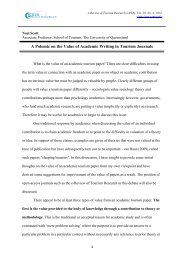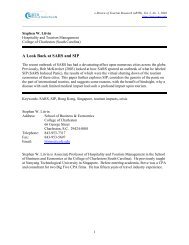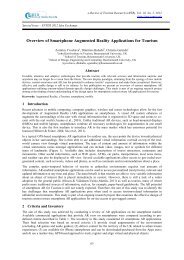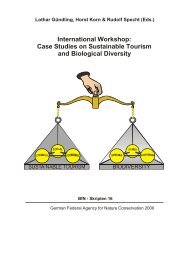3138_eRTR_Mohamad - e-Review of Tourism Research (eRTR)
3138_eRTR_Mohamad - e-Review of Tourism Research (eRTR)
3138_eRTR_Mohamad - e-Review of Tourism Research (eRTR)
Create successful ePaper yourself
Turn your PDF publications into a flip-book with our unique Google optimized e-Paper software.
e-<strong>Review</strong> <strong>of</strong> <strong>Tourism</strong> <strong>Research</strong> (<strong>eRTR</strong>), Vol. 8, No. 5, 2010<br />
http://ertr.tamu.edu/<br />
Abang Azlan <strong>Mohamad</strong><br />
May-Chiun Lo<br />
Peter Songan, and<br />
Alvin Yeo Wee<br />
Universiti Malaysia Sarawak<br />
ICTS AND TOURISTS’ SATISFACTION. A TEST ON A RURAL TOURIST<br />
DESTINATION<br />
This study examines the impact <strong>of</strong> ICTs in local communities. This study was conducted in<br />
Bario, a rural tourism destination located in the state <strong>of</strong> Sarawak, Malaysia. The results<br />
indicate that ICTs are able to increase the number <strong>of</strong> visitors. The study also demonstrates the<br />
important dimensions that contribute to tourists’ satisfaction so that future ICT efforts can be<br />
focused on them. The findings revealed that most <strong>of</strong> the visitors were aware <strong>of</strong> Bario because<br />
<strong>of</strong> its publicity through the website.<br />
Keywords: ICTs, tourists’ satisfaction, rural destination, Malaysia<br />
Abang Azlan <strong>Mohamad</strong><br />
Universiti Malaysia Sarawak, Faculty <strong>of</strong> Economics and Business, 94300 Sarawak, Malaysia<br />
Tel: +60 82 582459; Fax: 60 82 671 794, Email: maazlan@feb.unimas.my<br />
Mr. Abang Azlan <strong>Mohamad</strong> is a Senior Lecturer with the Faculty <strong>of</strong> Economics and<br />
Business, Universiti Malaysia Sarawak (UNIMAS). He studied Finance and Marketing at<br />
The University <strong>of</strong> Montana, USA and holds a Master <strong>of</strong> Business Administration from<br />
Arkansas State University, USA. He is currently teaching the courses <strong>of</strong> Marketing and is<br />
involved in consultancy and community projects under UNIMAS.<br />
May-Chiun Lo<br />
Universiti Malaysia Sarawak, Faculty <strong>of</strong> Economics and Business, 94300 Sarawak, Malaysia<br />
Tel: +60 82 582360; Fax: 60 82 671 794, Email: mclo@feb.unimas.my<br />
Dr. Lo May Chiun is a Senior Lecturer and Corporate MBA coordinator with the Faculty <strong>of</strong><br />
Economics & Business, University <strong>of</strong> Malaysia Sarawak (UNIMAS). She graduated with<br />
First Class Honours in Finance from Universiti Kebangsaan Malaysia and holds a Master <strong>of</strong><br />
Business Administration from Herriot-Watt University, United Kingdom, while her Ph.D in<br />
123
e-<strong>Review</strong> <strong>of</strong> <strong>Tourism</strong> <strong>Research</strong> (<strong>eRTR</strong>), Vol. 8, No. 5, 2010<br />
http://ertr.tamu.edu/<br />
Management was awarded by Universiti Sains Malaysia. Dr. Lo’s areas <strong>of</strong> expertise include<br />
corporate leadership, strategic management, entrepreneurship, banking, and financial<br />
management, and she has published more than 30 journal articles on related topics.<br />
Peter Songan<br />
Universiti Malaysia Sarawak, Chancellery, 94300 Sarawak, Malaysia<br />
Tel: +60 82665102; Fax: 60 82 665111, E-mail: songan@cans.unimas.my<br />
Dr. Peter Songan is currently the Deputy Vice Chancellor in-charge <strong>of</strong> <strong>Research</strong> and<br />
Innovation, and a pr<strong>of</strong>essor <strong>of</strong> human resource development at the Faculty <strong>of</strong> Cognitive<br />
Science and Human Development, Universiti Malaysia Sarawak. He obtained his PhD in<br />
Adult, Extension and Continuing Education, with minors in Industrial and Labor Relations,<br />
and International Agriculture and Rural Development from Cornell University, Ithaca, U.S.A.<br />
Dr Peter Songan has also been actively involved in conducting consultancy projects mostly in<br />
the area <strong>of</strong> social impact studies and community and rural development. One <strong>of</strong> the major<br />
research projects that he is currently involved with is the DAGS Rollout Rural Informatics<br />
Project, an <strong>of</strong>fshoot <strong>of</strong> the e-Bario Project.<br />
Alvin Yeo Wee<br />
Universiti Malaysia Sarawak, Faculty <strong>of</strong> Computer Science and Information Technology,<br />
Universiti Malaysia Sarawak, 94300 Sarawak, Malaysia<br />
Tel: +60 82 583765; Fax: 60 82 583 764, Email: alvin@fit.unimas.my<br />
Dr. Alvin Yeo Wee is the Director <strong>of</strong> the Centre <strong>of</strong> Excellence for Rural Informatics and an<br />
Associate Pr<strong>of</strong>essor at the Faculty <strong>of</strong> Computer Science and Information Technology,<br />
Universiti Malaysia Sarawak (UNIMAS). He has expertise in the area <strong>of</strong> Information and<br />
Communications Technology for Rural Development (ICT4RD). In addition to ICT4RD<br />
research, Alvin is also active in Human Computer Interaction research, specifically in<br />
s<strong>of</strong>tware internationalisation, multimodal interaction, gazed based systems, and the use <strong>of</strong><br />
ICTs for the preservation <strong>of</strong> indigenous languages. Alvin earned his PhD from the Computer<br />
Science Department, University <strong>of</strong> Waikato, New Zealand.<br />
124
e-<strong>Review</strong> <strong>of</strong> <strong>Tourism</strong> <strong>Research</strong> (<strong>eRTR</strong>), Vol. 8, No. 5, 2010<br />
http://ertr.tamu.edu/<br />
Introduction<br />
The development <strong>of</strong> information and communication technologies (ICTs) has brought<br />
knowledge to millions <strong>of</strong> people and has created new opportunities and choices for many<br />
others. The learning, working, and personal lives <strong>of</strong> people have changed rapidly since the<br />
birth <strong>of</strong> the global "information society". It is commonly known that the presence <strong>of</strong> ICTs<br />
<strong>of</strong>fers remarkable assistance in reducing poverty and generating employment prospects.<br />
Nonetheless, some <strong>of</strong> the world’s population remains untouched by this revolution. Barriers<br />
to access, high costs and minimal human resources are preventing these people from reaping<br />
the benefits <strong>of</strong> ICTs. It is found that insufficient attention has been given to the use <strong>of</strong> ICTs<br />
by indigenous people who <strong>of</strong>ten live in an environment <strong>of</strong> isolation, relative deprivation, and<br />
dependence.<br />
The problem with rural destinations is that the rural community’s level <strong>of</strong> knowledge<br />
and skillfulness on average is found to be much lower than in the city. This hinders efforts to<br />
bring development into the region and may severely damage a destination. Rural destinations<br />
may also run the risk <strong>of</strong> destroying their heritage if tourism development is not managed<br />
carefully.<br />
Literature <strong>Review</strong><br />
In most countries, ecotourism has been actively promoted by governments and<br />
industry players without an overall effective strategy, successful protected area management<br />
plans, and without consultation or inclusion <strong>of</strong> local communities. Past studies have found<br />
that development projects are <strong>of</strong>ten designed and implemented in a political context in which<br />
indigenous people have minimal voice in policy and management. As a result, many<br />
indigenous people rightly feel that the tourism industry has a poor track record, disregarding<br />
their legitimate interests and rights, and pr<strong>of</strong>iting from their cultural knowledge. Therefore,<br />
125
e-<strong>Review</strong> <strong>of</strong> <strong>Tourism</strong> <strong>Research</strong> (<strong>eRTR</strong>), Vol. 8, No. 5, 2010<br />
http://ertr.tamu.edu/<br />
partnerships between the tourism industry, government agencies, and the local population are<br />
needed in which local populations are able to articulate their initial concerns, wants and needs<br />
in relation to any development (Wearing & Neil, 1999). As such, the effectiveness <strong>of</strong><br />
ecotourism in the future will ultimately depend on who will benefit, as well as where, when<br />
and how it can be appropriately implemented with the assistance <strong>of</strong> ICTs.<br />
The tourist destination in this study is Bario, a remote rural community, located on the<br />
island <strong>of</strong> Borneo, close to the Malaysia-Indonesia border between Sarawak, Malaysia and<br />
Kalimantan, Indonesia. In the event that ICTs are successfully adopted by all existing<br />
relevant providers <strong>of</strong> tourism goods and services in the rural tourism destination, they provide<br />
the possibility <strong>of</strong> generating more income for the local people, allowing the destination to<br />
create a reasonable development strategy which prevents the destruction <strong>of</strong> natural and<br />
cultural heritage, <strong>of</strong>fering better quality services and products, and, subsequently, the<br />
possibility <strong>of</strong> presenting these products and services in tourism markets on a higher<br />
pr<strong>of</strong>essional level.<br />
Bario Highlands, located in the state <strong>of</strong> Sarawak, Malaysia has been selected due to its<br />
remoteness. The question guiding this research was how well rural communities were able to<br />
respond to the usage <strong>of</strong> ICTs to benefit the local tourism industry. The purpose <strong>of</strong> this paper<br />
is to investigate the impact <strong>of</strong> ICTs on the Bario tourism industry and to identify the<br />
dimensions that influence tourists’ satisfaction.<br />
Despite the importance <strong>of</strong> the impact ICTs can have on rural communities, little<br />
research has been done to examine the subsequent impact <strong>of</strong> ICTs on rural tourism industries.<br />
This study is unique in a sense that a rural community such as Bario is remotely situated from<br />
the outside world. This study is even more pr<strong>of</strong>ound as Bario does not have one <strong>of</strong> the most<br />
important aspects <strong>of</strong> basic infrastructure, which is electricity. A team <strong>of</strong> researchers from<br />
Universiti Malaysia Sarawak (UNIMAS) explored the possibility <strong>of</strong> bringing the Internet to<br />
126
e-<strong>Review</strong> <strong>of</strong> <strong>Tourism</strong> <strong>Research</strong> (<strong>eRTR</strong>), Vol. 8, No. 5, 2010<br />
http://ertr.tamu.edu/<br />
Bario by conceiving a study entitled the “eBario Project”. One <strong>of</strong> the toughest hurdles <strong>of</strong> this<br />
project was the absence <strong>of</strong> electricity at the targeted destination, as Bario does not have a 24<br />
hour electricity supply. Another aim <strong>of</strong> this research project was to explore the opportunities<br />
by which the deployment <strong>of</strong> ICTs can bring about social development within remote<br />
communities in Sarawak. The catch-phrase <strong>of</strong> the project was that if one could successfully<br />
implement such a project in Bario, one can do so anywhere. Paradoxically, a rural area such<br />
as Bario may be seen as more flexible and agile enough to make rapid responses to change. It<br />
is believed that successful implementation <strong>of</strong> ICTs would assist the remote community to be<br />
more self sufficient and to be a more sustainable community both socially and economically.<br />
ICT projects in the past have been found to assist rural communities by giving them<br />
opportunities to access news, information, advice, and knowledge. This has assisted them in<br />
making decisions in their daily activities. It is believed that creating information-rich<br />
societies is one <strong>of</strong> the ways to reduce poverty and sustain development. ICTs are important<br />
for geographically isolated rural places as tourism is likely to be the only growth industry<br />
(Irvine & Anderson, 2004) and tourism remains central to rural development (Briedenhann &<br />
Wickens, 2003). It is commonly known that small rural businesses such as tourism businesses<br />
<strong>of</strong>ten have to be self-sufficient, flexible and less reliant on outsiders (North & Smallbone,<br />
1996).<br />
Another argument is that with the help <strong>of</strong> ICTs, tourism players at a local destination<br />
are better able to improve on providing quality services to their tourists by capitalizing on<br />
drivers <strong>of</strong> tourists’ satisfaction such as places <strong>of</strong> interest, outdoor activities, and atmosphere<br />
<strong>of</strong> the rural destination. Past research stressed that these attributes can be developed for a<br />
destination to achieve competitive advantage over other substitute tourist destinations<br />
(Ibrahim and Gill, 2005, Alegre and Clagera 2007). Furthermore, tourists’ comments,<br />
complaints and suggestions are valuable sources <strong>of</strong> ideas for improvements and innovations<br />
127
e-<strong>Review</strong> <strong>of</strong> <strong>Tourism</strong> <strong>Research</strong> (<strong>eRTR</strong>), Vol. 8, No. 5, 2010<br />
http://ertr.tamu.edu/<br />
at the tourist destination and can be better elicited with ICTs (Dmitrovic´, Cvelbar, Kolar,<br />
Brencˇicˇ, Ograjensˇek and Zˇabkar, 2009).<br />
Methodology<br />
This study focuses on tourists who visited Bario between August 2009<br />
and January 2010, as a population <strong>of</strong> interest. Initially, interviews were carried<br />
out with 15 tourists who had visited Bario. Structured questionnaires were<br />
subsequently developed and tested where the question items were further<br />
categorized as places <strong>of</strong> interests/culture, resort/homestay atmosphere, outdoor<br />
activities, scenery, interest/motive <strong>of</strong> visits and tourism services provided. A<br />
random sampling procedure was employed on a possible sample <strong>of</strong><br />
approximately 200 tourists who have visited Bario. Data was collected through<br />
survey questionnaires from tourists. Respondents were asked to rate their perception using<br />
5-point Likert scales with: 5 = highly satisfied, 4 =satisfied, 3 = neutral, 2 = dissatisfied, and 1 =<br />
highly dissatisfied for all the items. A higher score indicates greater satisfaction. Only 146<br />
foreign and local tourists responded to the survey giving a response rate <strong>of</strong><br />
about 73 percent. In addition, researchers discovered through secondary data<br />
analysis that the introduction <strong>of</strong> ICTs by the eBario project in 1999 was<br />
responsible in luring tourists to Bario. The number <strong>of</strong> tourists visiting Bario has<br />
since increased tremendously from four (4) in 1997 to seven hundred and three<br />
(703) in 2007.<br />
128
e-<strong>Review</strong> <strong>of</strong> <strong>Tourism</strong> <strong>Research</strong> (<strong>eRTR</strong>), Vol. 8, No. 5, 2010<br />
http://ertr.tamu.edu/<br />
<strong>Research</strong> Findings<br />
Table 1 illustrates the demographic pr<strong>of</strong>ile <strong>of</strong> the respondents. Slightly more than half<br />
(53.4%) <strong>of</strong> the respondents are male, with a very high percentage stating that they had never<br />
visited Bario prior to this visit (93.2% <strong>of</strong> total respondents) and the majority <strong>of</strong> the<br />
respondents mentioned that they would like to visit Bario again (84.8%). 32.2% <strong>of</strong> the<br />
respondents hold a Bachelor’s degree, followed by those who have a Master’s degree<br />
(27.4%), PhD (6.2%), and the remainder (32.9%) are those with high school or lower<br />
education. 86.3% <strong>of</strong> visitors surveyed are foreigners, and most visitors (46.6%) have an<br />
income level <strong>of</strong> more than US$25,700.<br />
Table 1: Demographic Characteristic <strong>of</strong> Respondents<br />
Demographics Frequency Percentage<br />
Gender<br />
Male<br />
Female<br />
78<br />
68<br />
53.4<br />
46.6<br />
Education<br />
High school or lower<br />
Bachelor<br />
Master<br />
Doctorate<br />
Missing<br />
48<br />
47<br />
40<br />
9<br />
2<br />
32.9<br />
32.2<br />
27.4<br />
6.2<br />
1.4<br />
Visited Bario before<br />
Yes<br />
No<br />
10<br />
136<br />
6.8<br />
93.2<br />
Intention to visit again Yes<br />
No<br />
Income $25,700<br />
Missing<br />
123<br />
22<br />
32<br />
6<br />
6<br />
8<br />
68<br />
26<br />
84.2<br />
14.4<br />
21.9<br />
4.1<br />
4.1<br />
5.5<br />
46.6<br />
17.8<br />
Nationality<br />
Foreign<br />
Local<br />
126<br />
20<br />
86.3<br />
13.7<br />
129
e-<strong>Review</strong> <strong>of</strong> <strong>Tourism</strong> <strong>Research</strong> (<strong>eRTR</strong>), Vol. 8, No. 5, 2010<br />
http://ertr.tamu.edu/<br />
Source <strong>of</strong> Information<br />
Magazine<br />
Newspaper<br />
Internet<br />
Words <strong>of</strong> Mouth<br />
Friends<br />
Others<br />
8<br />
3<br />
63<br />
21<br />
21<br />
30<br />
5.5<br />
2.1<br />
43.3<br />
14.4<br />
14.4<br />
20.6<br />
Importantly, most <strong>of</strong> the visitors had learned about Bario through the internet<br />
(43.3%), suggesting that ICTs were indeed influencing tourism at the destination.<br />
The means among the study variables are presented in Table 2. As shown in Table 2,<br />
places <strong>of</strong> interest were evaluated the highest, followed by atmosphere <strong>of</strong> the homestay/resort,<br />
scenery, and lastly interest/motive and outdoor activities.<br />
Table 2: Descriptive for the Major Constructs<br />
Major Constructs<br />
Mean<br />
Places 4.4<br />
Scenery 4.1<br />
Outdoor 4.0<br />
Atmosphere 4.3<br />
Interest 4.0<br />
Satisfaction 4.3<br />
Table 3 illustrates the intercorrelations among the service quality subscales obtained<br />
using Pearson correlation to determine whether the subscales were independent measures <strong>of</strong><br />
the same concept. Generally, the values indicating intercorrelations among the predictor<br />
variables were low to moderate, ranging from .35 to .62 (p
e-<strong>Review</strong> <strong>of</strong> <strong>Tourism</strong> <strong>Research</strong> (<strong>eRTR</strong>), Vol. 8, No. 5, 2010<br />
http://ertr.tamu.edu/<br />
places scenery Outdoor atmosphere interest satisfaction<br />
Places 1<br />
Scenery .37 ** 1<br />
Outdoor .62 ** .47 ** 1<br />
Atmosphere .51 ** .39 ** .37 ** 1<br />
Interest .35 ** .38 ** .40 ** .35 ** 1<br />
Satisfaction .61 ** .48 ** .55 ** .63 ** .29** 1<br />
*p
e-<strong>Review</strong> <strong>of</strong> <strong>Tourism</strong> <strong>Research</strong> (<strong>eRTR</strong>), Vol. 8, No. 5, 2010<br />
http://ertr.tamu.edu/<br />
Discussion<br />
This study evidenced the importance <strong>of</strong> ICTs in generating more visitors and stressed<br />
the vital service quality dimensions as perceived by tourists.<br />
As stated by Baker and<br />
Cameron (2007), with the help <strong>of</strong> ICTs, the participants in the tourism industry would be able<br />
to appreciate their destination’s natural environment, the strengths and weaknesses <strong>of</strong> the<br />
tourism destination, as a basis to formulate effective strategies to develop the tourism<br />
industry. It is undeniable that the tourism industry relies heavily on networking to build a<br />
pr<strong>of</strong>itable tourism destination and through learning and exchange between network<br />
participants, benefits that are leveraged can turn into pr<strong>of</strong>it making business and positive<br />
community outcomes (Lynch, Halcro, Johns, & Buick, 2000; Morrison, Lynch, & Johns,<br />
2004).<br />
This research highlights the importance <strong>of</strong> ICTs, which help in bringing tourists to a<br />
destination. However, ICT use also needs to support service delivery. Hence, exploring the<br />
phenomenon <strong>of</strong> quality <strong>of</strong> service perceptions among visitors <strong>of</strong> Bario has broadened the<br />
understanding <strong>of</strong> the satisfaction level <strong>of</strong> the customers and the influences on it. Ultimately,<br />
local community and industry players in particular will benefit from focusing on the areas <strong>of</strong><br />
service quality that need close scrutiny and improvements and drive tourist satisfaction. Since<br />
quality <strong>of</strong> “Outdoor activities” is the main contributor to tourists’ satisfaction but is currently<br />
rated low, it is important for Bario tourism to focus on improving outdoor activities. One <strong>of</strong><br />
the ways to do that is to promote outdoor activities on the Internet for tourists to be aware <strong>of</strong><br />
what to expect when they come to visit Bario. Various outdoor packages can be promoted<br />
through the Internet for tourists to choose the type that best suits their capabilities and<br />
interests. Outdoor guides also have the opportunity to promote themselves through the<br />
Internet as a way <strong>of</strong> informing potential tourists on their areas <strong>of</strong> expertise. ICTs also allow<br />
local guides to inform themselves, equipping themselves with valuable skills and knowledge<br />
132
e-<strong>Review</strong> <strong>of</strong> <strong>Tourism</strong> <strong>Research</strong> (<strong>eRTR</strong>), Vol. 8, No. 5, 2010<br />
http://ertr.tamu.edu/<br />
useful when guiding tourists. Since Bario is remotely located, there is limited access to<br />
“physical” information; hence, ICTs are critical for guides searching for information.<br />
The findings illustrate that the implementation <strong>of</strong> this project has successfully assisted<br />
a remote community in attracting tourism. Hence, the next step is to take note <strong>of</strong> the<br />
important dimensions <strong>of</strong> service quality as perceived by tourists to be made known to tourism<br />
industry players and to strike a balance between the inevitably diverse interests.<br />
Conclusion<br />
It is believed that creating information-rich societies is one way to reduce poverty and<br />
sustain development. The increase in tourist arrivals will result in better employment<br />
opportunities, which result in higher revenue for communities in ecotourism destinations. The<br />
bigger objective is to improve the livelihood and raise the quality <strong>of</strong> lives <strong>of</strong> the local<br />
community. More youths and their families are willing to make a living in rural destinations<br />
by operating homestay lodges and other tourism-related activities. <strong>Tourism</strong> in rural areas can<br />
help reduce rural-urban migration.<br />
This research underlines the importance <strong>of</strong> ICTs on rural tourism development which<br />
could serve as a valuable approach to achieve a better repositioning <strong>of</strong> rural destinations. This<br />
study perhaps is the first that has systematically attempted to integrate ICTs and highlighted<br />
the important dimensions <strong>of</strong> service quality needed in rural tourism development. It is<br />
interesting to note how local communities first are attracted to the usage <strong>of</strong> ICTs and later<br />
utilise it to generate income for their tourism business. This study can serve as a “best<br />
practice” example as it has proven the ability <strong>of</strong> the eBario project by bringing the Internet to<br />
rural destinations to better economic livelihoods in a remote rural destination such as Bario.<br />
Without a doubt, research on rural tourism development is still limited in its ability to provide<br />
unequivocal guidelines and to advice on the best way to sustain and preserve rural<br />
133
e-<strong>Review</strong> <strong>of</strong> <strong>Tourism</strong> <strong>Research</strong> (<strong>eRTR</strong>), Vol. 8, No. 5, 2010<br />
http://ertr.tamu.edu/<br />
destinations. This study provides important insights regarding the role <strong>of</strong> ICTs in rural<br />
development processes.<br />
134
e-<strong>Review</strong> <strong>of</strong> <strong>Tourism</strong> <strong>Research</strong> (<strong>eRTR</strong>), Vol. 8, No. 5, 2010<br />
http://ertr.tamu.edu/<br />
References<br />
Alegre, J., & Cladera, M. (2009). Analysing the effect <strong>of</strong> satisfaction and previous visits on<br />
tourist intentions to return, European Journal <strong>of</strong> Marketing, 43,5/6, 670-685.<br />
Baker, D. & Crompton, J. (2000). Quality, satisfaction and behavioural intentions. Annals <strong>of</strong><br />
<strong>Tourism</strong> <strong>Research</strong>, 27, 3, 785-804.<br />
Briedenhann, J., & Wickens, E. (2003). <strong>Tourism</strong> routes as a tool for the economic<br />
development <strong>of</strong> rural areas: Vibrant hope or impossible dream? <strong>Tourism</strong><br />
Management, 25, 1, 71-79.<br />
Dmitrovic´, T., Cvelbar, L.K., Kolar, T., Brencˇicˇ, M.M., Ograjensˇek, I., & Zˇabkar, V.<br />
(2009). Conceptualizing tourist satisfaction at the destination level, International<br />
Journal <strong>of</strong> Culture, <strong>Tourism</strong> And Hospitality <strong>Research</strong>, 3, 2, 116-126.<br />
Ibrahim, E., E., & Gill, J. (2005). A positioning strategy for a tourist destination, based on<br />
analysis <strong>of</strong> customers’ perceptions and satisfactions. Marketing Intelligence &<br />
Planning, 23, 2, 172 – 188.<br />
Irvine, W., & Anderson, A. R. (2004). Small tourist firms in rural areas: Agility, vulnerability<br />
and survival in the face <strong>of</strong> crisis. International Journal <strong>of</strong> Entrepreneurial Behavior &<br />
<strong>Research</strong>, 10, 4, 229-246.<br />
Lynch, P. A., Halcro, K., Johns, N., Buick, I. (2000). Developing small and micro-enterprise<br />
networks to build pr<strong>of</strong>itable tourist destinations. Destination Development<br />
Conference, ETOUR, Mid-Sweden University, Ostersund, Sweden.<br />
Morrison, A., Lynch, P., & Johns, N. (2004). International tourism network. International<br />
Journal <strong>of</strong> Contemporary Hospitality Management, 16, 3, 197-202.<br />
North, D., & Smallborne, D. (1996). Small business development in remote rural areas: The<br />
example <strong>of</strong> mature manufacturing firms in remote rural areas: The example <strong>of</strong> mature<br />
manufacturing firms in northern England. Journal <strong>of</strong> Rural Studies, 12, 2, 151-167.<br />
135











